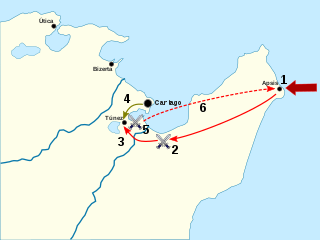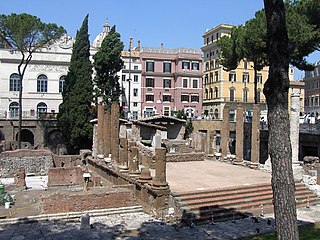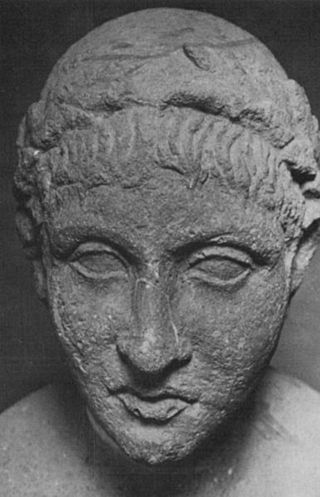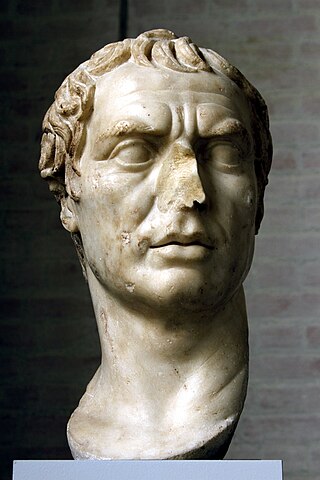
The First Punic War was the first of three wars fought between Rome and Carthage, the two main powers of the western Mediterranean in the early 3rd century BC. For 23 years, in the longest continuous conflict and greatest naval war of antiquity, the two powers struggled for supremacy. The war was fought primarily on the Mediterranean island of Sicily and its surrounding waters, and also in North Africa. After immense losses on both sides, the Carthaginians were defeated.

Year 216 BC was a year of the pre-Julian Roman calendar. At the time it was known as the Year of the Consulship of Varro and Paullus. The denomination 216 BC for this year has been used since the early medieval period, when the Anno Domini calendar era became the prevalent method in Europe for naming years.
Hamilcar Barca or Barcas was a Carthaginian general and statesman, leader of the Barcid family, and father of Hannibal, Hasdrubal and Mago. He was also father-in-law to Hasdrubal the Fair.

The Battle of Cannae was a key engagement of the Second Punic War between the Roman Republic and Carthage, fought on 2 August 216 BC near the ancient village of Cannae in Apulia, southeast Italy. The Carthaginians and their allies, led by Hannibal, surrounded and practically annihilated a larger Roman and Italian army under the consuls Lucius Aemilius Paullus and Gaius Terentius Varro. It is regarded as one of the greatest tactical feats in military history and one of the worst defeats in Roman history, and it cemented Hannibal Barca's reputation as one of antiquity's greatest tacticians.

Lucius Aemilius Paullus, also spelled Paulus, was a consul of the Roman Republic twice, in 219 and 216 BC. He is primarily remembered for being one of the commanders of the Roman army at the Battle of Cannae, and for his death in the same battle.

The gens Aemilia, originally written Aimilia, was one of the greatest patrician families at ancient Rome. The gens was of great antiquity, and claimed descent from Numa Pompilius, the second King of Rome. Its members held the highest offices of the state, from the early decades of the Republic to imperial times. The Aemilii were almost certainly one of the gentes maiores, the most important of the patrician families. Their name was associated with three major roads, an administrative region of Italy, and the Basilica Aemilia at Rome.
Xanthippusof Lacedaemon, or of Carthage, was a Spartan mercenary general employed by Carthage during the First Punic War. He led the Carthaginian army to considerable success against the Roman Republic during the course of the war, training the army to a professional standard before defeating the Romans at the Battle of Tunis, where Carthaginian forces routed the Roman expeditionary force and captured the Roman consul Marcus Atilius Regulus in 255 BC.

The Battle of Cape Ecnomus or Eknomos was a naval battle, fought off southern Sicily, in 256 BC, between the fleets of Carthage and the Roman Republic, during the First Punic War. The Carthaginian fleet was commanded by Hanno and Hamilcar; the Roman fleet jointly by the consuls for the year, Marcus Atilius Regulus and Lucius Manlius Vulso Longus. It resulted in a clear victory for the Romans.

The Battle of the Bagradas River, also known as the Battle of Tunis, was a victory by a Carthaginian army led by Xanthippus over a Roman army led by Marcus Atilius Regulus in the spring of 255 BC, nine years into the First Punic War. The previous year, the newly constructed Roman navy established naval superiority over Carthage. The Romans used this advantage to invade Carthage's homeland, which roughly aligned with modern-day Tunisia in North Africa. After landing on the Cape Bon Peninsula and conducting a successful campaign, the fleet returned to Sicily, leaving Regulus with 15,500 men to hold the lodgement in Africa over the winter.

The battle of Adys took place in late 256 BC during the First Punic War between a Carthaginian army jointly commanded by Bostar, Hamilcar and Hasdrubal and a Roman army led by Marcus Atilius Regulus. Earlier in the year, the new Roman navy had established naval superiority and used this advantage to invade the Carthaginian homeland, which roughly aligned with modern Tunisia in North Africa. After landing on the Cape Bon Peninsula and conducting a successful campaign, the fleet returned to Sicily, leaving Regulus with 15,500 men to hold the lodgement in Africa over the winter.

The gens Lutatia, occasionally written Luctatia, was a plebeian family of ancient Rome. The first of the gens to obtain the consulship was Gaius Lutatius Catulus in 242 BC, the final year of the First Punic War. Orosius mentions their burial place, the sepulchrum Lutatiorum, which lay beyond the Tiber.

Publius Cornelius Scipio Nasica Corculum was a politician of the Roman Republic. Born into the illustrious family of the Cornelii Scipiones, he was one of the most important Roman statesmen of the second century BC, being consul two times in 162 and 155 BC, censor in 159 BC, pontifex maximus in 150 BC, and finally princeps senatus in 147 BC.
Lucius Aemilius Papus was a Roman general and statesman. He jointly commanded the Roman armies which defeated the Gauls at the Battle of Telamon in 225 BC; his co-Consul, Gaius Atilius Regulus was killed during the battle. Papus was honoured with a triumph for this victory. He subsequently held several senior positions. He belonged to the patrician gens Aemilia.
Lucius Valerius Flaccus was a Roman statesman and general during the middle era of the Roman Republic. He was one of the two consuls of 261 BCE, serving with Titus Otacilius Crassus. Together they fought in the ongoing First Punic War; they campaigned in Sicily. Before sailing to Sicily they strengthened the coastal defences of Italy against attacks by Hannibal Gisco, a Carthaginian admiral sent to raid the Tyrrhenian coast. The consuls besieged Mytistraton, but were eventually driven off by Hamilcar, the new commander of Carthage's Sicilian army, who inflicted a defeat on them at Thermae near Palermo. They returned to Italy were they started building a fleet. This fleet was the first Roman fleet of war ships ever and created after Carthaginian example. In 260, this fleet was ready.

The gens Postumia was a noble patrician family at ancient Rome. Throughout the history of the Republic, the Postumii frequently occupied the chief magistracies of the Roman state, beginning with Publius Postumius Tubertus, consul in 505 BC, the fifth year of the Republic. Although like much of the old Roman aristocracy, the Postumii faded for a time into obscurity under the Empire, individuals bearing the name of Postumius again filled a number of important offices from the second century AD to the end of the Western Empire.

Publius Cornelius Scipio Africanus was a Roman general and statesman, most notable as one of the main architects of Rome's victory against Carthage in the Second Punic War. Often regarded as one of the greatest military commanders and strategists of all time, his greatest military achievement was the defeat of Hannibal at the Battle of Zama in 202 BC. This victory in Africa earned him the honorific epithet Africanus, literally meaning "the African," but meant to be understood as a conqueror of Africa.
Titus Otacilius Crassus was a Roman statesman and general during the middle era of the Roman Republic. He was one of the two consuls of 261 BCE, serving with Lucius Valerius Flaccus. During his consulship, he and his consular colleague Flaccus fought against the Carthaginians on Sicily as part of the ongoing First Punic War. Before sailing to Sicily they strengthened the coastal defences of Italy against attacks by Hannibal Gisco, a Carthaginian admiral sent to raid the Tyrrhenian coast. The consuls besieged Mytistraton, but were eventually driven off by Hamilcar, the new commander of Carthage's Sicilian army, who defeated them at Thermae near Palermo. They returned to Italy were they started building Rome's first warfleet, created after Carthaginian example. In 260, the fleet was ready and would be used by Gnaeus Cornelius Scipio Asina, one of the two consuls of that year.
The Roman withdrawal from Africa was the attempt by the Roman Republic in 255 BC to rescue the survivors of their defeated expeditionary force to Carthaginian Africa during the First Punic War. A large fleet commanded by Servius Fulvius Paetinus Nobilior and Marcus Aemilius Paullus successfully evacuated the survivors after defeating an intercepting Carthaginian fleet, but was struck by a storm while returning, losing most of its ships.
Servius Fulvius Paetinius Nobilior was a Roman statesman and general during the middle era of the Roman Republic. He was one of the two consuls of 255 BCE, serving with Marcus Aemilius Paullus. He was consul during the First Punic War against Carthage. Paetinus and his consular colleague led a Roman fleet of 350 warships to Africa to rescue the remnants of the army of proconsul Marcus Atilius Regelus, who had been defeated at the Battle of the Bagradas River during their consulship. En route they defeated a Carthaginian fleet of 200 warships in the Battle of Cape Hermaeum.
Gaius Sempronius Blaesus was a Roman statesman and general during the middle era of the Roman Republic. He was one of the two consuls of 253 BCE, serving with Gnaeus Servilius Caepio. He was consul during the First Punic War against Carthage. During his consulship Blaesus led a Roman fleet to Africa and pillaged the Libyo-phoenician coast all the way to the island of Menix before sailing back to Italy via Panormus on Sicily. On his way back to Italy his fleet was hit by a violent storm sinking 150 ships.











